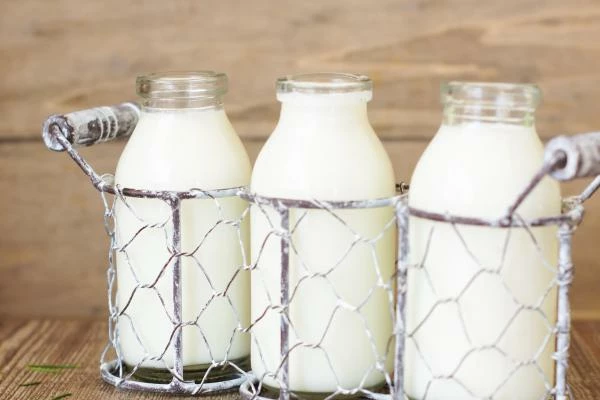
Apr 29, 2025
IndexBox has just published a new report: EU – Skim Milk of Cows – Market Analysis, Forecast, Size, Trends and Insights.
The European Union skim milk market is expected to see steady growth over the period from 2024 to 2035, with a forecasted CAGR of +0.2% in volume and +0.6% in value. This upward trend is projected to bring the market volume to 52M tons and market value to $25.6B by the end of 2035, driven by increasing consumer demand.
Market Forecast
Driven by increasing demand for skim milk in the European Union, the market is expected to continue an upward consumption trend over the next decade. Market performance is forecast to retain its current trend pattern, expanding with an anticipated CAGR of +0.2% for the period from 2024 to 2035, which is projected to bring the market volume to 52M tons by the end of 2035.
In value terms, the market is forecast to increase with an anticipated CAGR of +0.6% for the period from 2024 to 2035, which is projected to bring the market value to $25.6B (in nominal wholesale prices) by the end of 2035.

Consumption
European Union’s Consumption of Skim Milk
In 2024, consumption of skim milk decreased by -0.3% to 51M tons for the first time since 2019, thus ending a four-year rising trend. In general, consumption, however, saw a relatively flat trend pattern. The growth pace was the most rapid in 2021 with an increase of 5% against the previous year. Over the period under review, consumption hit record highs at 53M tons in 2018; however, from 2019 to 2024, consumption failed to regain momentum.
The value of the skim milk market in the European Union contracted to $23.9B in 2024, shrinking by -5.9% against the previous year. This figure reflects the total revenues of producers and importers (excluding logistics costs, retail marketing costs, and retailers’ margins, which will be included in the final consumer price). Overall, consumption, however, showed a relatively flat trend pattern. The pace of growth was the most pronounced in 2021 with an increase of 8.6%. Over the period under review, the market attained the peak level at $26.2B in 2022; however, from 2023 to 2024, consumption failed to regain momentum.
Consumption By Country
The countries with the highest volumes of consumption in 2024 were Germany (12M tons), France (9.1M tons) and the Netherlands (4.5M tons), with a combined 50% share of total consumption.
From 2013 to 2024, the biggest increases were recorded for the Netherlands (with a CAGR of +3.8%), while consumption for the other leaders experienced more modest paces of growth.
In value terms, the largest skim milk markets in the European Union were Germany ($4.5B), France ($3.4B) and the Netherlands ($3.3B), together accounting for 47% of the total market.
The Netherlands, with a CAGR of +4.3%, saw the highest rates of growth with regard to market size in terms of the main consuming countries over the period under review, while market for the other leaders experienced more modest paces of growth.
In 2024, the highest levels of skim milk per capita consumption was registered in Ireland (871 kg per person), followed by Denmark (302 kg per person), the Netherlands (258 kg per person) and Belgium (243 kg per person), while the world average per capita consumption of skim milk was estimated at 115 kg per person.
From 2013 to 2024, the average annual rate of growth in terms of the skim milk per capita consumption in Ireland stood at +2.2%. In the other countries, the average annual rates were as follows: Denmark (+0.2% per year) and the Netherlands (+3.4% per year).
Production
European Union’s Production of Skim Milk
Skim milk production reached 51M tons in 2024, therefore, remained relatively stable against the previous year. Over the period under review, production showed a relatively flat trend pattern. The pace of growth appeared the most rapid in 2021 when the production volume increased by 5%. The volume of production peaked at 53M tons in 2018; however, from 2019 to 2024, production failed to regain momentum. The general positive trend in terms output was largely conditioned by a relatively flat trend pattern of the number of producing animals and a relatively flat trend pattern in yield figures.
In value terms, skim milk production reduced to $23.7B in 2024 estimated in export price. In general, production continues to indicate a relatively flat trend pattern. The pace of growth was the most pronounced in 2021 when the production volume increased by 9% against the previous year. Over the period under review, production hit record highs at $26.5B in 2022; however, from 2023 to 2024, production remained at a lower figure.
Production By Country
The countries with the highest volumes of production in 2024 were Germany (12M tons), France (9.2M tons) and the Netherlands (4.5M tons), together comprising 51% of total production.
From 2013 to 2024, the biggest increases were recorded for the Netherlands (with a CAGR of +4.3%), while production for the other leaders experienced more modest paces of growth.
Imports
European Union’s Imports of Skim Milk
In 2024, after two years of growth, there was significant decline in purchases abroad of skim milk, when their volume decreased by -30% to 728K tons. Over the period under review, imports showed a perceptible decline. The most prominent rate of growth was recorded in 2017 when imports increased by 17% against the previous year. As a result, imports reached the peak of 1.3M tons. From 2018 to 2024, the growth of imports failed to regain momentum.
In value terms, skim milk imports declined rapidly to $409M in 2024. Overall, imports continue to indicate a noticeable curtailment. The growth pace was the most rapid in 2020 when imports increased by 29%. Over the period under review, imports reached the maximum at $738M in 2021; however, from 2022 to 2024, imports failed to regain momentum.
Imports By Country
Italy (252K tons) and Belgium (185K tons) represented roughly 60% of total imports in 2024. Germany (74K tons) took the next position in the ranking, followed by Spain (33K tons). All these countries together took near 15% share of total imports. The Netherlands (29K tons), the Czech Republic (25K tons), Poland (20K tons), Ireland (20K tons), France (15K tons) and Romania (13K tons) held a relatively small share of total imports.
From 2013 to 2024, the biggest increases were recorded for Poland (with a CAGR of +16.4%), while purchases for the other leaders experienced more modest paces of growth.
In value terms, Belgium ($118M), Italy ($84M) and France ($50M) appeared to be the countries with the highest levels of imports in 2024, with a combined 62% share of total imports. Germany, the Netherlands, Spain, Ireland, Poland, the Czech Republic and Romania lagged somewhat behind, together comprising a further 26%.
In terms of the main importing countries, Poland, with a CAGR of +18.9%, saw the highest rates of growth with regard to the value of imports, over the period under review, while purchases for the other leaders experienced more modest paces of growth.
Import Prices By Country
The import price in the European Union stood at $562 per ton in 2024, therefore, remained relatively stable against the previous year. Over the period under review, the import price showed slight growth. The pace of growth was the most pronounced in 2020 when the import price increased by 37% against the previous year. The level of import peaked at $870 per ton in 2021; however, from 2022 to 2024, import prices stood at a somewhat lower figure.
Prices varied noticeably by country of destination: amid the top importers, the country with the highest price was France ($3,364 per ton), while the Czech Republic ($242 per ton) was amongst the lowest.
From 2013 to 2024, the most notable rate of growth in terms of prices was attained by France (+13.6%), while the other leaders experienced more modest paces of growth.
Exports
European Union’s Exports of Skim Milk
In 2024, exports of skim milk in the European Union shrank sharply to 652K tons, waning by -16% compared with the year before. Over the period under review, exports recorded a deep contraction. The pace of growth appeared the most rapid in 2017 with an increase of 12% against the previous year. The volume of export peaked at 1.5M tons in 2013; however, from 2014 to 2024, the exports stood at a somewhat lower figure.
In value terms, skim milk exports declined significantly to $283M in 2024. Overall, exports continue to indicate a abrupt decrease. The most prominent rate of growth was recorded in 2017 with an increase of 28%. Over the period under review, the exports attained the peak figure at $711M in 2013; however, from 2014 to 2024, the exports remained at a lower figure.
Exports By Country
Germany (193K tons) and France (165K tons) were the largest exporters of skim milk in 2024, reaching near 30% and 25% of total exports, respectively. Austria (61K tons) held the next position in the ranking, followed by the Netherlands (35K tons). All these countries together took approx. 15% share of total exports. The following exporters – Denmark (22K tons), Belgium (22K tons), Ireland (22K tons), Poland (21K tons), Spain (16K tons) and Latvia (12K tons) – together made up 18% of total exports.
From 2013 to 2024, the most notable rate of growth in terms of shipments, amongst the leading exporting countries, was attained by the Netherlands (with a CAGR of +5.5%), while the other leaders experienced mixed trends in the exports figures.
In value terms, the largest skim milk supplying countries in the European Union were Germany ($74M), France ($62M) and the Netherlands ($23M), together comprising 56% of total exports. Austria, Denmark, Spain, Belgium, Poland, Ireland and Latvia lagged somewhat behind, together comprising a further 30%.
Denmark, with a CAGR of +7.9%, saw the highest rates of growth with regard to the value of exports, in terms of the main exporting countries over the period under review, while shipments for the other leaders experienced mixed trends in the exports figures.
Export Prices By Country
The export price in the European Union stood at $434 per ton in 2024, reducing by -5.8% against the previous year. Overall, the export price saw a relatively flat trend pattern. The most prominent rate of growth was recorded in 2016 when the export price increased by 22%. The level of export peaked at $522 per ton in 2018; however, from 2019 to 2024, the export prices failed to regain momentum.
Prices varied noticeably by country of origin: amid the top suppliers, the country with the highest price was Spain ($842 per ton), while Austria ($321 per ton) was amongst the lowest.
From 2013 to 2024, the most notable rate of growth in terms of prices was attained by Denmark (+6.4%), while the other leaders experienced more modest paces of growth.





